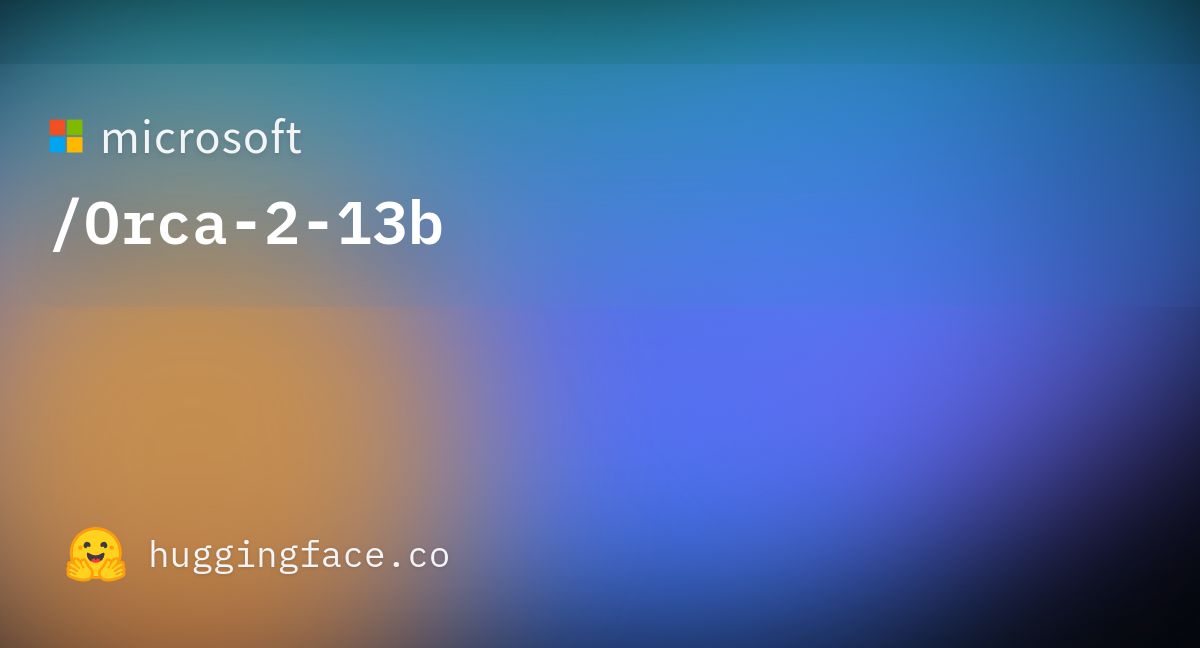As the digital sun sets over the horizon of artificial intelligence, a new titan emerges from the depths of code and algorithms, challenging the Goliaths of the AI world. Microsoft's latest brainchild, Orca 2, is creating ripples that are fast turning into waves. This isn't just another update; it's a paradigm shift, proving that size isn't everything when it comes to neural networks. Orca 2 is teaching us that David can indeed teach Goliath a lesson or two in reasoning.
Anakin AI can help you easily create any AI app with highly customized workflow, with access to Many, Many AI models such as GPT-4-Turbo, Claude-2-100k, API for Midjourney & Stable Diffusion, and much more!

Interested? Check out Anakin AI and test it out for free!👇👇👇
What is Orca 2?
At its core, Orca-2-13B is a testament to Microsoft's commitment to refining the intelligence and reasoning capabilities of AI. It is a language model that operates on a leaner parameter scale—7 billion and 13 billion—yet packs a punch comparable to its heavyweight counterparts boasting up to 70 billion parameters.
Orca-2-13b Hugging Face Page link:

This AI marvel achieves what most thought was reserved for the behemoths of tech: nuanced understanding, logical deduction, and a sophisticated grasp of context. Its array of benchmarks showcases a level of aptitude that shatters the glass ceiling for smaller models.
Orca 2-13B: Technical Details & Benchmarks
The power of Orca 2 lies in its sophisticated training regimen. Where larger models might provide a straightforward answer, Orca 2 employs a variety of solution strategies, depending on the task at hand. These include:
- Step-by-step processing
- Recall then generate
- Recall-reason-generate
- Extract-generate
- Direct answer
Each strategy is a cog in the intricate machinery of Orca 2's reasoning abilities. Let's delve into the benchmarks that prove Orca 2's prowess.
Compare Orca-2-13B to Other LLMs Models
When placed side by side with the larger LLaMA-2-Chat and WizardLM models, Orca 2's bar graph of performance is not just competitive; it's a leaderboard. In areas such as AGI and multi-step reasoning, Orca 2's bars rise high, matching or surpassing those of its larger brethren.

Orca-2-13B Benchmarks
In the BigBench causal judgment task, Orca 2 scored a multiple-choice grade of 0.6105, with a standard error of 0.0355. For a task that demands understanding the cause-and-effect relationships within data, this score is not merely impressive; it's a statement.

The model's understanding of dates—a task that trips up many AI systems due to its contextual and variable nature—mirrors this excellence with a score equally formidable. And when it comes to geometric shapes, a domain where spatial reasoning meets linguistic description, Orca 2 holds its own with a score that defies expectations for its size class.
In sports understanding, a domain rife with jargon and dynamic scenarios, Orca 2's score of 0.6630 shows its ability to grapple with complex, nuanced topics—a significant feat for a model of its stature.
Against the likes of the ARC challenge, Orca 2 not only stands its ground but shines with an accuracy of 0.5068. In the BoolQ benchmark, an open-domain question-answering benchmark that tests comprehension and practical knowledge, Orca 2 scores an astonishing 0.8826, demonstrating its remarkable grasp of everyday knowledge and its application.
Update, I benchmarked 13b Orca 2, its still not surpassing gpt4all score of Base Mistral or OpenHermes 2.5 7B:
— Teknium (e/λ) (@Teknium1) November 21, 2023
Hermes 2.5 7B Mistral score: 73.12%
Mistral Base 7B score: 71.16%
Orca 13B GPT4All score: 70.58% https://t.co/81FGjDrufE pic.twitter.com/LuAKb1Ce4s
Orca-2-13B: The Technical Deep Dive
Will Orca-2-13B Mainstream Synthetic Data Training for LLMs?
Orca 2's training data is a crafted collection of high-quality synthetic data, tailored to teach the model how to navigate a variety of reasoning pathways. The process involves detailed instructions from a more capable teacher model, which Orca 2 then learns to emulate and, eventually, innovate upon.
Benchmarking Orca-2-13B's Advanced Reasoning Abilities
Delving deeper into the specifics, let's examine the actual data from the benchmarks that highlight Orca 2's advanced reasoning abilities. Presented in a concise table format, we can observe the model's performance across various tasks:
| Task | Score (Value ± Stderr) |
|---|---|
| Causal Judgment | 0.6105 ± 0.0355 |
| Date Understanding | 0.6101 ± 0.0255 |
| Disambiguation QA | 0.3101 ± 0.0289 |
| Geometric Shapes | 0.1532 ± 0.0190 |
| Logical Deduction (5 Objects) | 0.3420 ± 0.0212 |
| Logical Deduction (7 Objects) | 0.2614 ± 0.0169 |
| Movie Recommendation | 0.2460 ± 0.0193 |
| Navigation | 0.5400 ± 0.0158 |
| Reasoning About Colored Objects | 0.5065 ± 0.0112 |
| Salient Translation Error Detection | 0.4353 ± 0.0235 |
| Sports Understanding | 0.6630 ± 0.0352 |
| Temporal Sequence | 0.7069 ± 0.0142 |
The above table encapsulates the performance of Orca 2, showcasing how it measures up to tasks that challenge different aspects of reasoning. These tasks range from understanding causal relationships to navigating complex logical deductions involving multiple objects. Orca 2's scores are particularly notable in sports understanding and temporal sequence tasks, which require a sophisticated grasp of context and the ability to process information over time.
Harnessing the Power of Orca-2-13B with Ollama
For developers and AI enthusiasts eager to leverage Orca 2's reasoning capabilities, the Ollama command-line interface provides an accessible gateway.
You can visit Ollama's website to pull the Orca 2 model right now. Below are detailed steps and sample codes to help you get started:
- Installation: Ensure that you have the Ollama CLI tool installed on your system. If not, you can usually install it via package managers like pip or by following the instructions on the official Ollama documentation page.
Running the Model: To run Orca 2 for generating responses, use the following command:
ollama run orca2For more complex tasks that might benefit from the larger 13B model, use:
ollama run orca2:13bAPI Interaction: Orca 2 can also be used via API calls. Here's an example of using the API to ask Orca 2 why the sky is blue:
curl -X POST http://localhost:11434/api/generate -d '{
"model": "orca2",
"prompt":"Why is the sky blue?"
}'- This sends a request to the Orca 2 model, which then generates a response based on its training and reasoning abilities.
Custom Prompts: You can also customize prompts to suit specific tasks. For instance, if you need to solve a math problem or require the model to explain a scientific concept, modify the 'prompt' field accordingly:
curl -X POST http://localhost:11434/api/generate -d '{
"model": "orca2",
"prompt":"What is the Pythagorean theorem?"
}'Conclusion: The Dawn of a New Era in AI with Orca 2-13B
As we wrap up our exploration of Orca 2, it's clear that Microsoft has not just raised the bar but also redefined it for what smaller language models can achieve. The detailed benchmarks and the ease of integration via Ollama are not mere features; they are beacons of a future where efficiency and advanced reasoning go hand-in-hand. Orca 2's performance is a testament to the meticulous engineering and the forward-thinking approach of Microsoft Research, offering a sustainable and accessible model that does not compromise on capability. This innovative leap forward paves the way for a broader application of AI in everyday tasks and complex problem-solving scenarios alike.
Orca 2 is more than just a model; it's a harbinger of a new paradigm where smaller, more intelligent systems can effectively perform tasks that were once the domain of their larger counterparts. It stands as a shining example of the potential of AI when ingenuity meets optimization, a combination that promises to revolutionize the field.
Want to boost your productivity with a No-Code AI Tool?
Anakin AI can help you easily create any AI app with highly customized workflow, with access to Many, Many AI models such as GPT-4-Turbo, Claude-2-100k, API for Midjourney & Stable Diffusion, and much more!

Interested? Check out Anakin AI and test it out for free!👇👇👇
FAQs
What is Orca from Microsoft?
Orca from Microsoft is an advanced language model designed to perform complex reasoning tasks that traditionally required much larger models. It employs a variety of innovative strategies to process and understand information, making it highly efficient and capable in a wide range of AI applications.
What is Orca software used for?
Orca software is used for a multitude of tasks that require advanced reasoning, such as language understanding, multi-step problem solving, comprehension, summarizing, and more. Its applications span from helping developers create more interactive and responsive AI systems to aiding researchers in understanding the capabilities and limitations of language models.
How do I access Microsoft Orca?
Microsoft Orca can be accessed via the Ollama command-line interface or through an API. Developers can run Orca using simple commands or make POST requests to the Orca API, which allows them to utilize the model's reasoning abilities in their applications or research.
What is the difference between Orca and ChatGPT?
Orca and ChatGPT are both language models, but they are designed with different focuses. Orca is specifically trained to employ a variety of reasoning techniques for enhanced performance in complex tasks, even with a smaller parameter count. ChatGPT, on the other hand, is optimized for generating human-like text based on prompts and is part of a family of models known for their conversational abilities. While Orca excels in reasoning and efficiency, ChatGPT is renowned for its fluency and versatility in dialogue.



